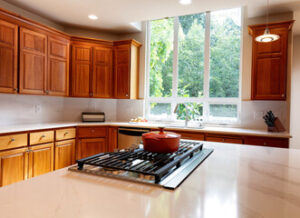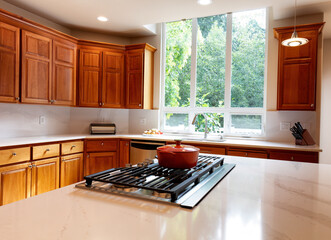Cabinet Refinishing Modesto Anchor is a cost-effective way to give your kitchen cabinets a fresh look. But it is important to consider your long-term goals when selecting a finish. Trends often fade and some colors may not withstand years of holiday feasting and weekday chaos.
To begin, your professional will sand and vacuum the surface before applying new stain or paint. Then, they will use filler to fix any minor scratches or dents.
Painting your cabinets is a big job, but it’s also an excellent way to give your kitchen a fresh new look. It’s important to use a high-quality paint, and it’s equally important to take the time to prepare your cabinets correctly. The first step is to clean the surfaces thoroughly. This ensures that your new coat of paint adheres well to the cabinet and prevents future chipping. Professionals often use a degreaser like trisodium phosphate to cut through grime.
You’ll also need to sand the surfaces before you start painting. Professionals use 220-grit sandpaper to scuff up the existing finish, which improves adhesion and creates a rough surface that will accept new layers of primer and paint. It’s also important to clean up the dust and debris after sanding.
Once the surfaces are clean and dry, it’s time to apply a coat of primer. You’ll want to apply this in a well-ventilated area, and make sure that you follow the manufacturer’s instructions for drying time. Some primers can require four hours to fully dry, while others need up to 24.
When it comes to painting your cabinets, you’ll want to choose an oil-based paint for wood and a latex paint for laminate or metal surfaces. Oil-based paints are more durable than latex and can withstand frequent washing. Professional painters will use a foam roller for large areas, and a soft-bristled brush to get into tight spots and corners.
Before you begin painting your cabinets, it’s important to remove any hardware, such as pulls or knobs. You’ll also need to empty your cabinets, and clean the insides with a degreaser. You can use a scrub brush and synthetic steel wool to scrub away grease and dirt. It’s also a good idea to label the doors and cabinet boxes with sticky notes so that you can put them back together correctly when the project is complete.
Once the primer has dried, it’s time to start painting. Most professional painters will start with the cabinet doors, then move on to the cabinet boxes. You’ll need to carefully follow the grain, and use a light touch when applying the paint. It’s also important to “tip-off” the surface between strokes, which helps to reduce the appearance of drips and sags.
Staining
Cabinet staining can offer a rich, luxurious look that paint can’t match. It can also conceal nicks, dings and scratches that have made their way into your cabinetry over time, creating an even, polished finish. While the process is more labor intensive than painting, it can transform your cabinetry in just a few days.
Staining can work on cabinets made from wood or engineered wood, such as medium-density fiberboard (MDF). This type of refinishing is ideal for older cabinetry that has endured years of holiday feasts, family life and general wear and tear. The key is to choose a color that works with your existing style and design scheme, and to take into account how the wood may darken or lighten over time.
Before staining, remove all cabinet doors and hardware, and clean the surfaces thoroughly with soapy water or a degreasing solution to help your new finish adhere. Use drop cloths or plastic sheeting to protect surfaces you don’t want stained, such as countertops or flooring. Once the surfaces are dry, sand them lightly to prepare for staining and wipe away any dust.
Apply a small amount of the desired stain to an inconspicuous part of your cabinetry, and let it dry before applying more. Always work with the grain of the wood to ensure an even finish, and don’t forget to lightly sand between coats for a smoother appearance. It’s a good idea to use a high-quality stain with low VOC (Volatile Organic Compounds) content, as this will minimize the impact of the stain on your indoor air quality.
Once your stain is applied and allowed to dry, seal the surface with a polyurethane for durability. Be sure to follow the manufacturer’s instructions for application, and allow the product to dry completely before reattaching the doors and hardware.
While staining is an easy, budget-friendly option for giving your cabinets a fresh new look, it’s not as durable as refacing. A quality refacing project typically takes just 3-5 days and causes minimal disruption, with no strong paint odors or extended downtime.
Filling
Cabinet refinishing isn’t just about changing the color or stain. It also involves making sure that the wooden surfaces are completely sealed to protect them from moisture and stains and prolong their appearance and lifespan. Your refinishing company will apply a high-quality sealant to the entire surface, which they will then sand down and vacuum. This step is one of the most important, as it will ensure that your new finish is durable and stands up to the test of time.
Once your cabinet refinishing is complete, you’ll need to carefully reassemble your cabinets, ensuring that each door and drawer slides properly into place. It’s important to use a labeling system when reassembling, and refer back to your labeling as necessary. Once all doors and drawers are reinstalled, you’ll need to reattach any hardware or hinges, using a hand tool instead of power drill to avoid stripping the existing screws. If you need to add any additional hardware, consider choosing brushed finishes to complement your kitchen’s aesthetic.
While refacing is more expensive than refinishing, it’s an excellent option for homeowners who want to give their kitchen a whole new look. However, it’s important to understand that refacing isn’t the right choice for all homeowners. In fact, refacing won’t work for cabinet boxes made of laminate or thermofoil, and it may not be the best choice if you plan to sell your home in the future.
Refacing also involves removing the interior of your cabinetry and replacing it with new shelves, hinges, and handles. However, it’s less extensive than a full refacing job, which can cost from a few thousand dollars to upwards of fifteen-thousand dollars, depending on your chosen material and style. Regardless of whether you choose to reface or refinish your cabinets, it’s a good idea to discuss your options with a professional before beginning any work. They can provide you with expert advice and help you choose the right product for your specific needs. You should also ask your contractor about their certifications and training, as well as what their process entails.
Reassembling
Cabinet refinishing is a great option for homeowners who are looking to change the color of their cabinets without breaking the bank. However, refinishing does come with its limitations. For example, refinishing can only be done on cabinet surfaces that are already finished. If you have unfinished wood or want to switch to a different stain, refacing is a better option. Refacing also allows you to change the door style and wood species, which can dramatically transform the look of a kitchen.
Refinishing is a labor-intensive project that requires expert skill to ensure beautiful results. It involves stripping the old finish, sanding, and painting the cabinets. Depending on the size of your kitchen and the complexity of your chosen finish, the process can take several days to a couple weeks. Before you begin, it is important to prepare the space by clearing out your cabinets, covering countertops and appliances with plastic and tape, and setting up a temporary workspace if necessary. This will help minimize cleanup and protect your home from damage during the process.
Once your cabinets are refinished, they will need to be sealed to protect them from moisture and stains. This will prolong their life and keep them looking their best. It is also a good idea to use an anti-microbial sealant, which will prevent mold and mildew growth in the future.
Another way to update your kitchen is by replacing the hardware. Cabinet knobs and pulls are available in a variety of styles, so you can choose the perfect ones to complement your decor. Cabinet hinges are available in many different finishes and sizes, so you can find the ones that match your existing cabinet doors.
Another option is to install new drawer fronts, which can make your cabinets look brand-new. This can be a great option for homeowners who are selling their house or simply want to give their kitchen a fresh look. Moreover, RTA cabinet fronts are lighter than traditional cabinets and can be easier to transport through narrow hallways and walk-up multifamily buildings. This is especially important in mountainside condominiums, where navigating switchback staircases would be difficult with full-sized cabinet boxes.


